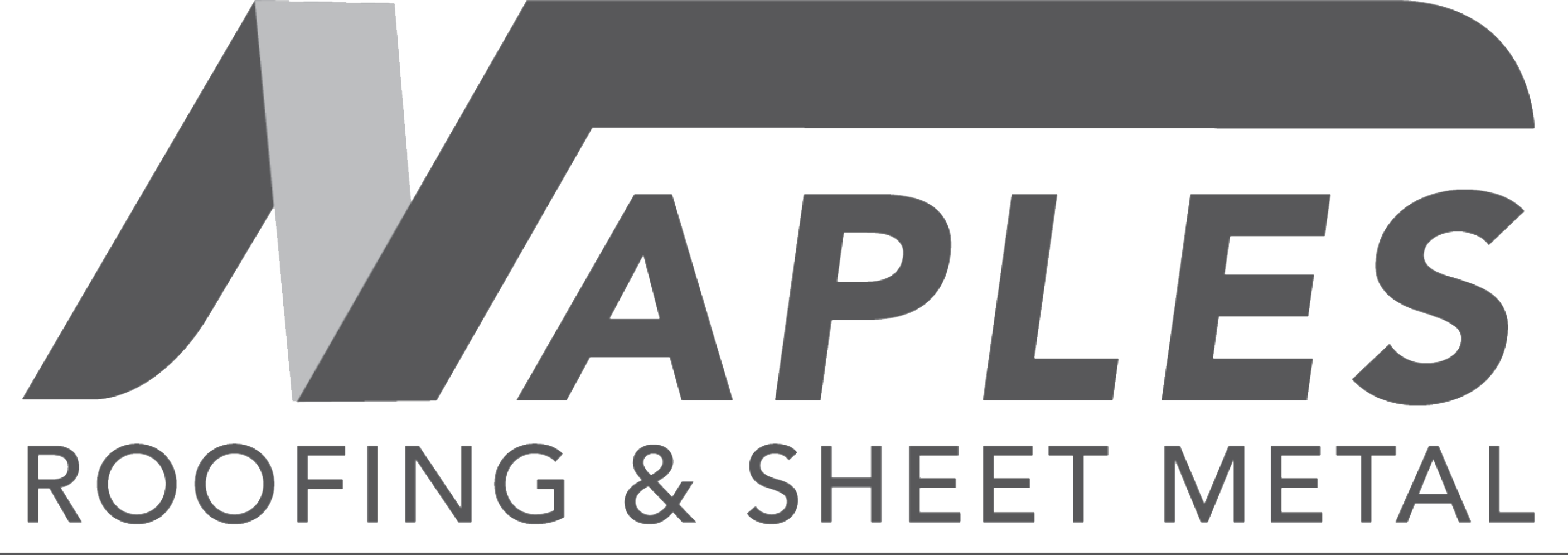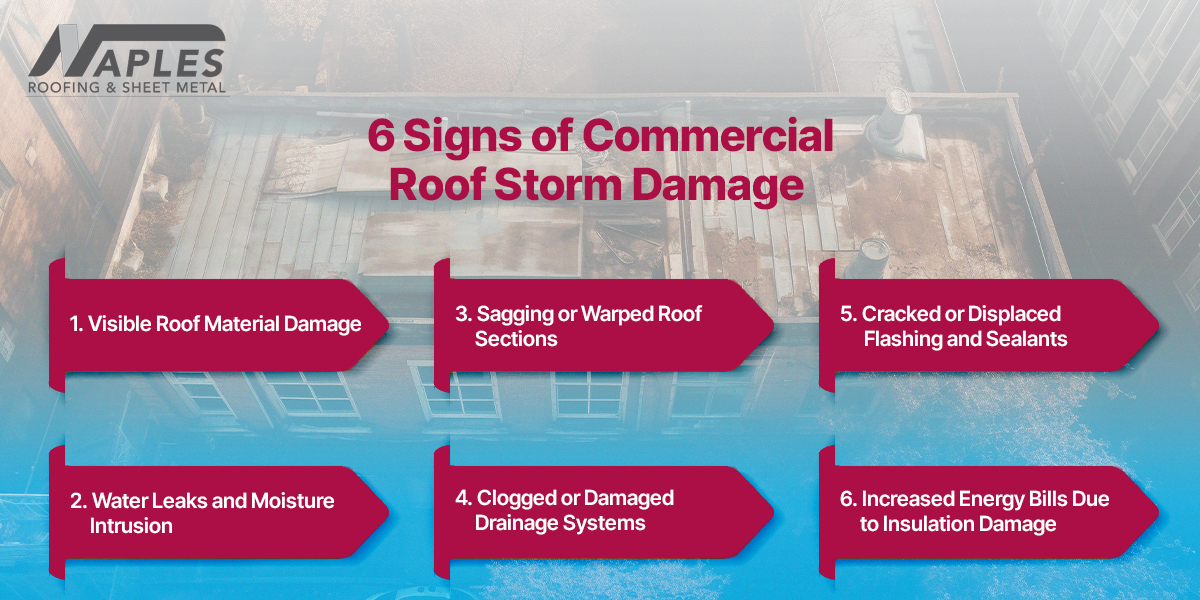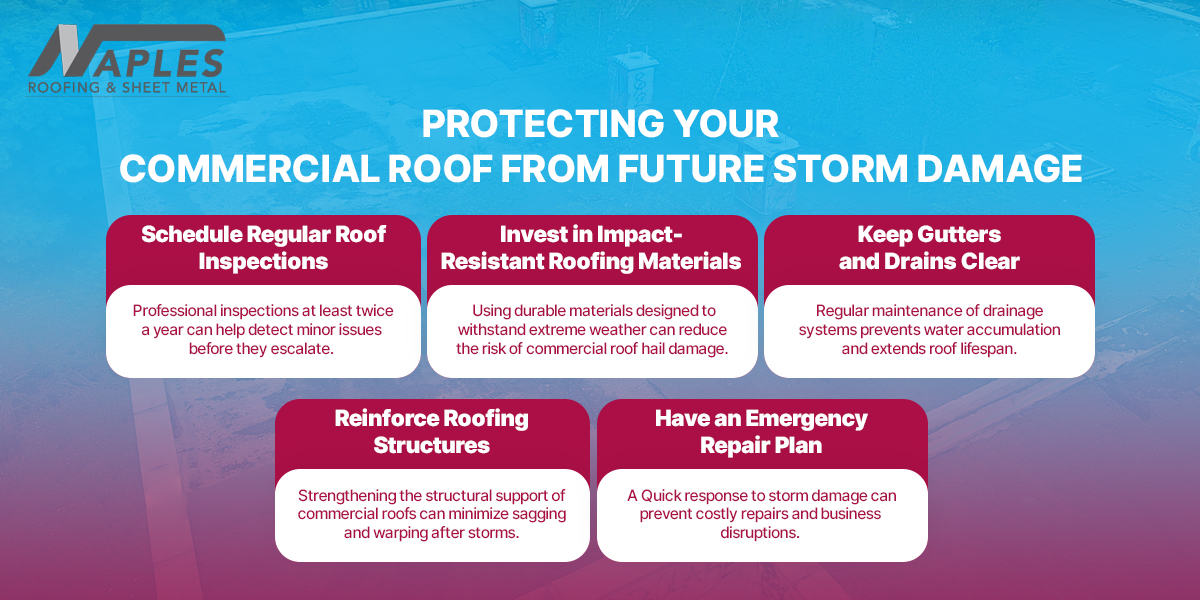6 Signs of Commercial Roof Storm Damage
In recent years, extreme weather conditions have become increasingly frequent, causing severe damage to commercial and industrial buildings. Storms with high winds, heavy rainfall, and hail can significantly impact the structural integrity of a building, leading to costly repairs if not addressed promptly. One of the most vulnerable parts of any commercial property is its roof. Commercial Roof Storm Damage is a growing concern for businesses, particularly those in regions prone to severe weather. Whether it’s industrial building hail damage, commercial roof damage, or warehouse hail damage, business owners must be vigilant in spotting early warning signs. Identifying storm damage quickly can save money, protect assets, and prevent further structural deterioration.
In this guide, we’ll discuss six critical signs of Commercial Roof Storm Damage, helping you take the necessary steps to maintain your property’s safety and longevity.
Commercial Roof Storm Damage: Signs You Shouldn’t Ignore
6 signs of a commercial roof storm damage are:-
1. Visible Roof Material Damage
One of the most apparent signs of Commercial Roof Storm Damage is visible damage to the roofing materials. High winds, hail, and heavy rain can crack, dent, or even tear roofing components apart. If your property has metal roofing, look for dings or dents from hail impact. For flat roofs, check for punctures, tears, or missing sections in the membrane. Industrial building hail damage is especially common in warehouses and factories with large, flat roofs that bear the brunt of storm impacts.
2. Water Leaks and Moisture Intrusion
After a storm, business owners should inspect their buildings for signs of leaks. Water stains on ceilings, damp walls, or puddles forming inside the building indicate roof damage. If left unaddressed, water intrusion can lead to mold growth, weakened structural integrity, and electrical hazards. Commercial roof hail damage can result in small punctures that may not be visible immediately but can cause long-term water infiltration issues.
3. Sagging or Warped Roof Sections
A storm can weaken the structural support of a commercial roof, leading to sagging or warping. If you notice uneven roof sections, pooling water, or a wavy appearance, these could be signs of Commercial Roof Storm Damage. This is particularly concerning for warehouse building hail damage, where large, open roof structures may be at higher risk of collapse under excessive weight from accumulated rain or hail.
4. Clogged or Damaged Drainage Systems
Storms often bring debris that can clog gutters, downspouts, and drainage systems, preventing water from properly flowing off the roof. When water accumulates on a commercial roof, it increases the risk of leaks, mold, and structural damage. Regularly inspect drainage points after a storm to ensure they are clear and functioning. Industrial building hail damage often leads to clogged drains filled with broken roofing materials, tree branches, and dirt.
5. Cracked or Displaced Flashing and Sealants
Flashing and sealants play a crucial role in preventing water from seeping into a commercial building. Strong winds and hail can loosen or crack these protective elements, allowing moisture to penetrate vulnerable areas. Damaged flashing is a common sign of Commercial Roof Storm Damage, and business owners should check areas around vents, chimneys, and skylights for potential issues. Commercial roof hail damage can be particularly harmful to flashing and sealants, as hail impact can weaken their protective properties.
6. Increased Energy Bills Due to Insulation Damage
One often-overlooked sign of Commercial Roof Storm Damage is a sudden increase in energy costs. When a storm damages insulation within a roof, the building loses its ability to regulate temperature efficiently. This leads to higher heating and cooling expenses as the HVAC system works harder to compensate for heat loss or gain. If your warehouse or industrial facility experiences a spike in energy bills after a storm, it may indicate warehouse building hail damage that has compromised insulation layers.
Protecting Your Commercial Roof from Future Storm Damage
Understanding the signs of Commercial Roof Storm Damage is essential, but prevention and timely repair are equally crucial. Here are some proactive steps to safeguard your commercial roof from future storms:
- Schedule Regular Roof Inspections: Professional inspections at least twice a year can help detect minor issues before they escalate.
- Invest in Impact-Resistant Roofing Materials: Using durable materials designed to withstand extreme weather can reduce the risk of commercial roof hail damage.
- Keep Gutters and Drains Clear: Regular maintenance of drainage systems prevents water accumulation and extends roof lifespan.
- Reinforce Roofing Structures: Strengthening the structural support of commercial roofs can minimize sagging and warping after storms.
- Have an Emergency Repair Plan: A Quick response to storm damage can prevent costly repairs and business disruptions.
Emergency Roof Repair Checklist
When a roofing emergency strikes, taking immediate action can prevent further damage and costly repairs. Follow this checklist to address urgent roofing issues effectively:
1. Ensure Safety First
Stay inside and assess the damage from a safe distance.
Avoid stepping onto a wet or damaged roof.
Watch out for electrical hazards or falling debris.
2. Inspect the Damage
Check for visible leaks or water stains on ceilings and walls.
Check for loose, broken, or missing shingles.
Examine gutters and downspouts for clogging or detachment.
Identify structural damage, sagging areas, or exposed underlayment.
3. Prevent Further Damage
To collect water, place buckets or other containers beneath leaks.
Cover damaged areas with a waterproof tarp (secure it properly).
Remove loose debris, if safe to do so, to prevent additional roof stress.
4. Document the Damage
Take detailed pictures and videos of every place that is impacted.
Make notes about the type and extent of damage.
Keep records for insurance claims and repair estimates.
5. Contact a Professional Roofer
Call a licensed roofing contractor for emergency repairs.
Request a thorough inspection and damage assessment.
Discuss temporary fixes if a full repair isn’t immediately possible.
Following this checklist will help you manage a roofing emergency efficiently while minimizing risks and expenses.
Conclusion: Take Action to Protect Your Business
Storms are unpredictable, but the damage they cause doesn’t have to be. By recognizing the six signs of Commercial Roof Storm Damage, business owners can take proactive steps to address issues before they worsen. Whether you manage an industrial facility, a warehouse, or an office building, maintaining a strong and well-inspected roof is key to protecting your assets.
If you suspect industrial building hail damage, commercial, or warehouse hail damage, contact a roofing professional immediately. Addressing these issues early can save your business thousands of dollars in repairs and ensure long-term structural integrity.
Naples Roofing is a trusted commercial roofing contractor specializing in installation, repair, and maintenance services across the U.S. With decades of experience, they provide high-quality roofing solutions for businesses, ensuring durability and efficiency. Their expert team handles various roofing systems, offering reliable, cost-effective services tailored to clients’ needs.



